Ice-Flow Dynamics During the Final Stage of the Fraser Glaciation (MIS2) in the Fraser Lowland, BC, Canada
Abstract
1. Introduction

2. Regional Setting
3. Materials and Methods

4. Results
4.1. Southern Coast Mountains
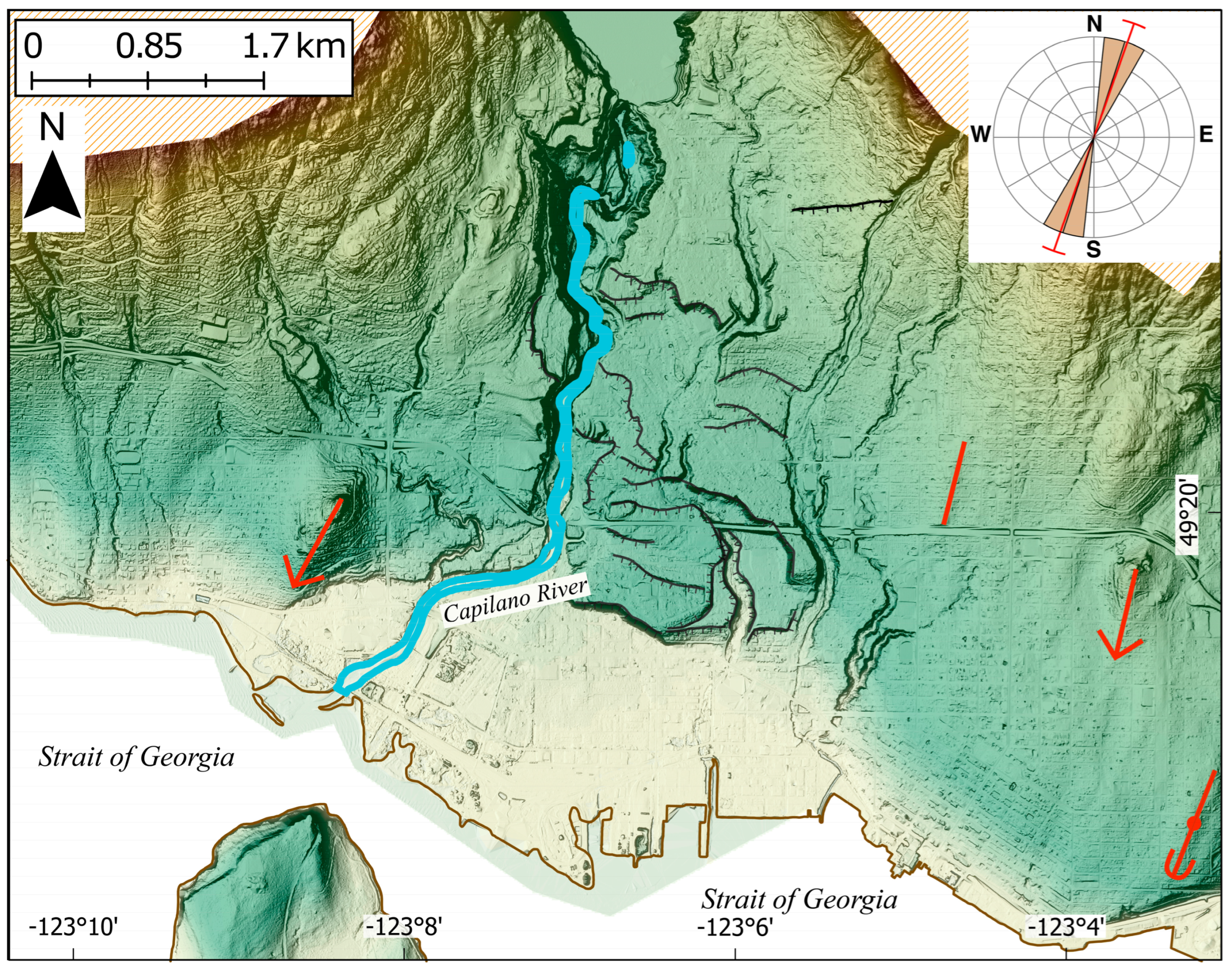
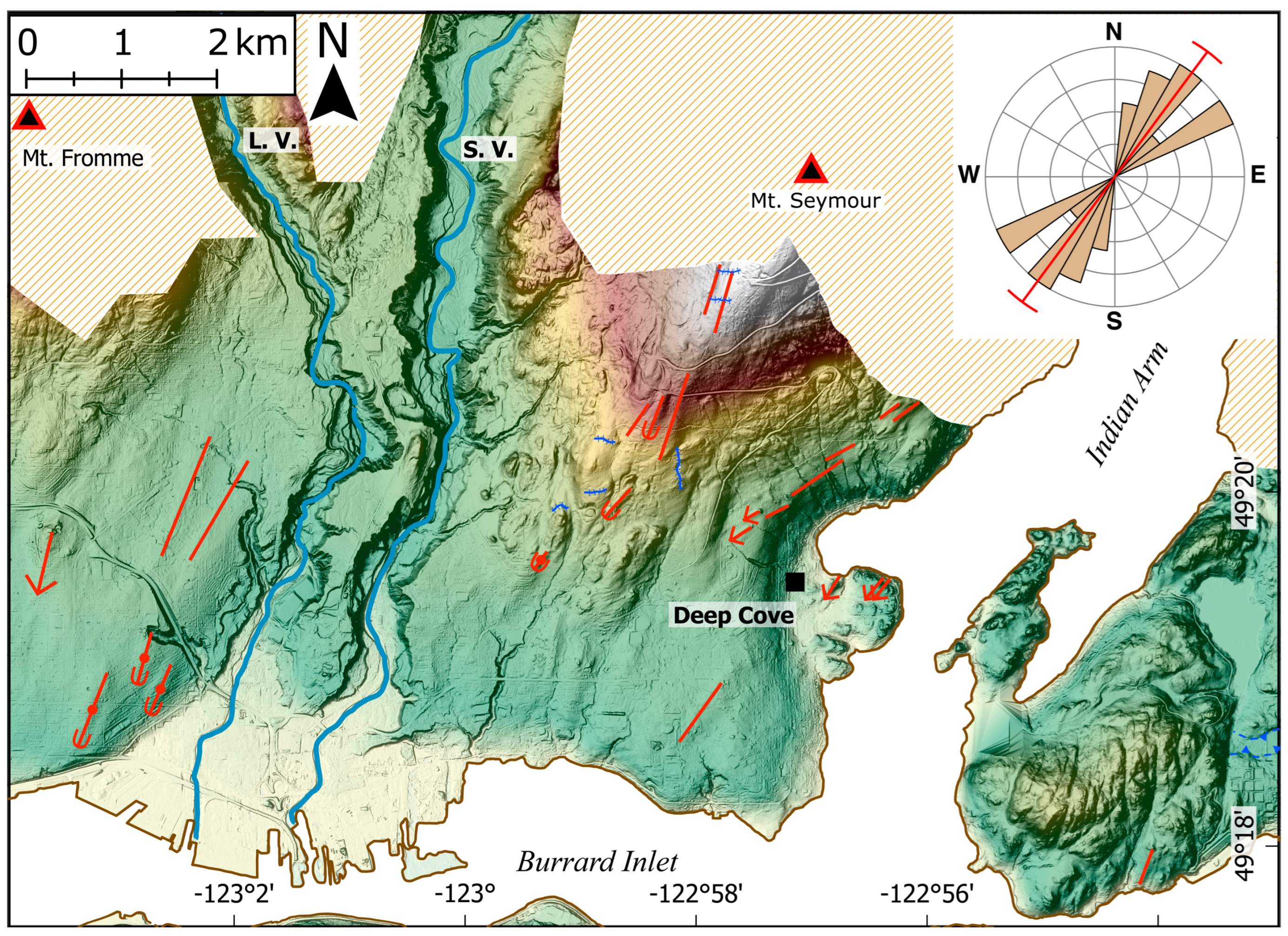
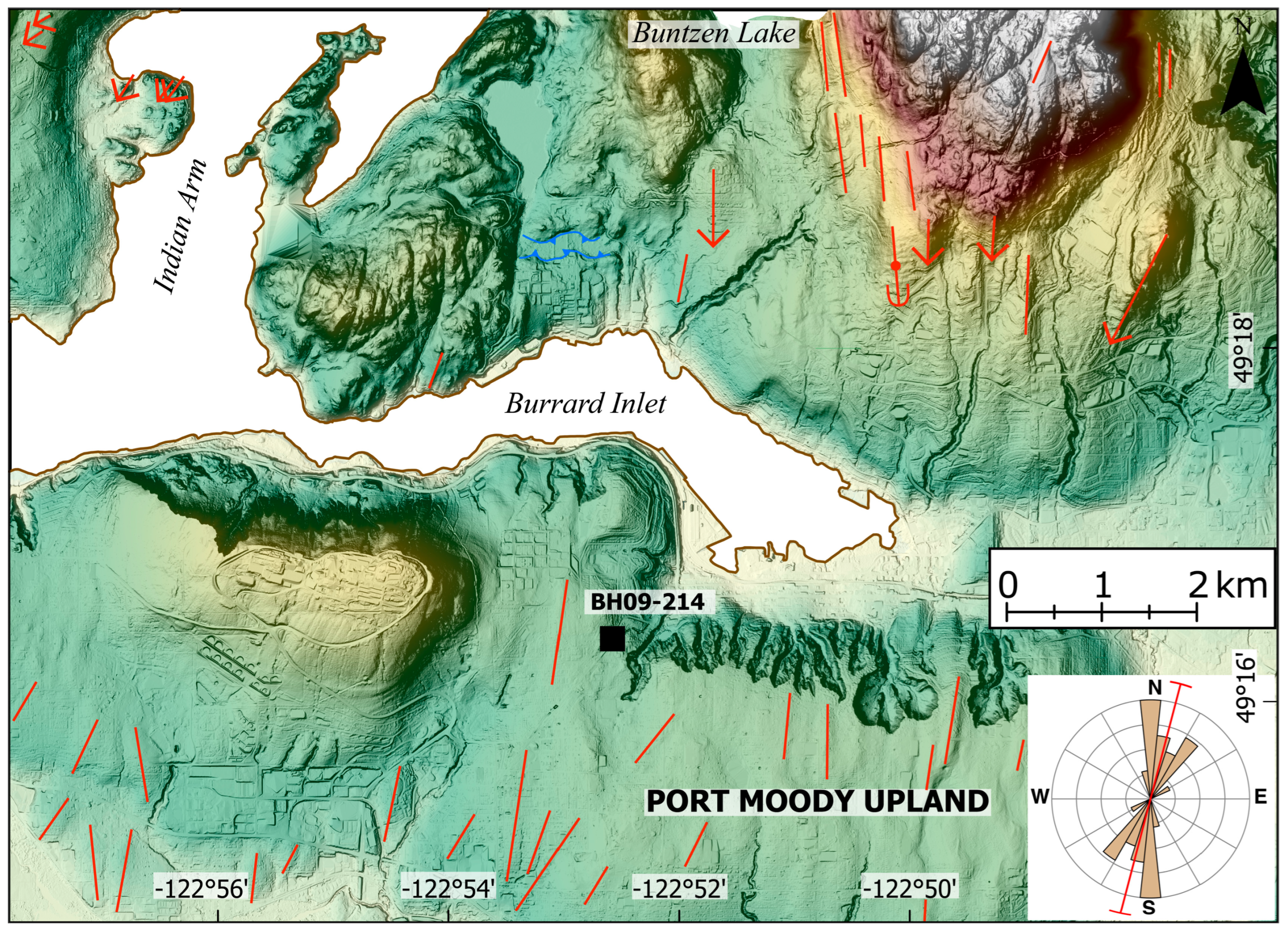
4.2. Burrard Upland
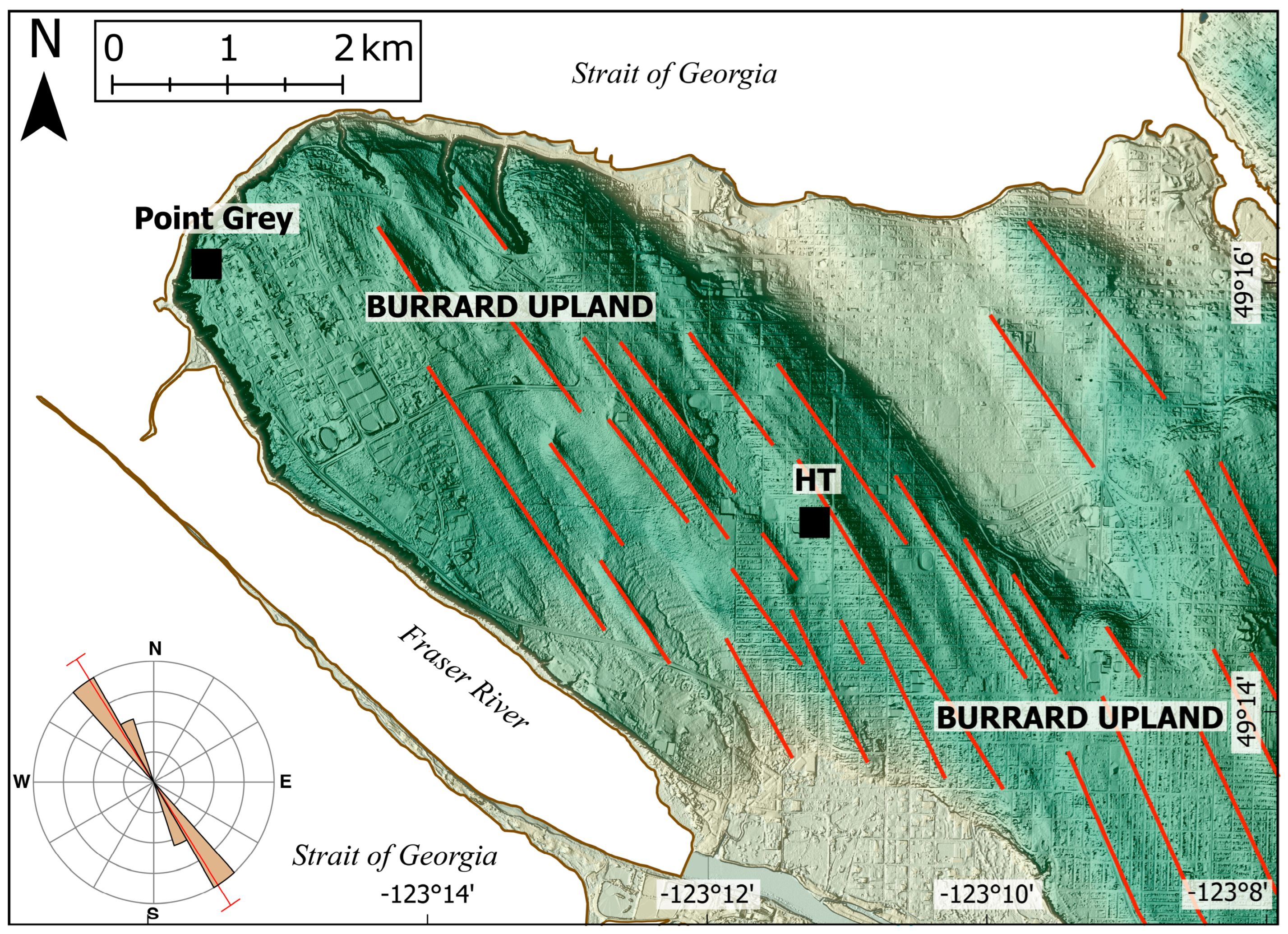
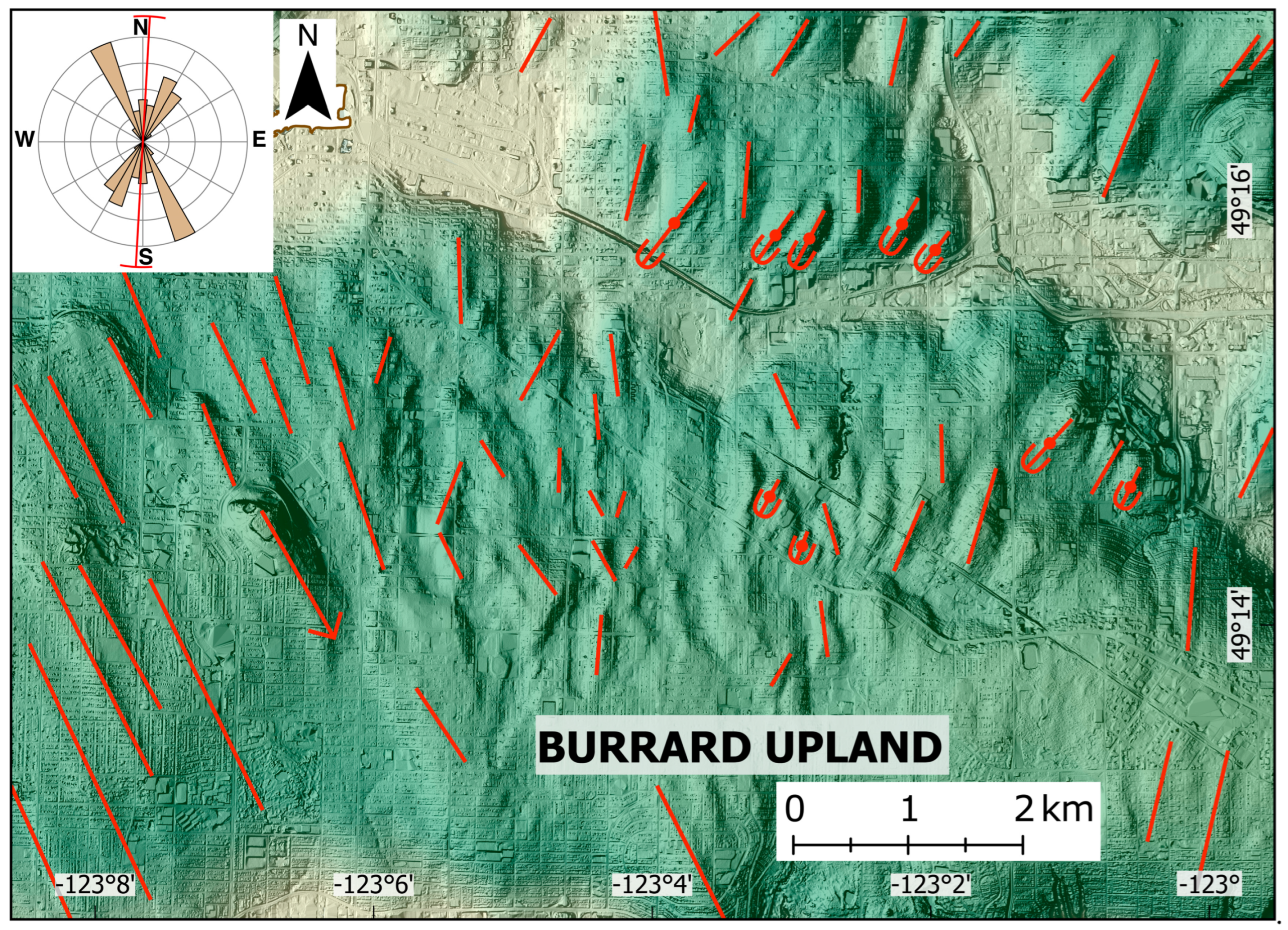
4.3. Surrey, Langley, and White Rock Uplands
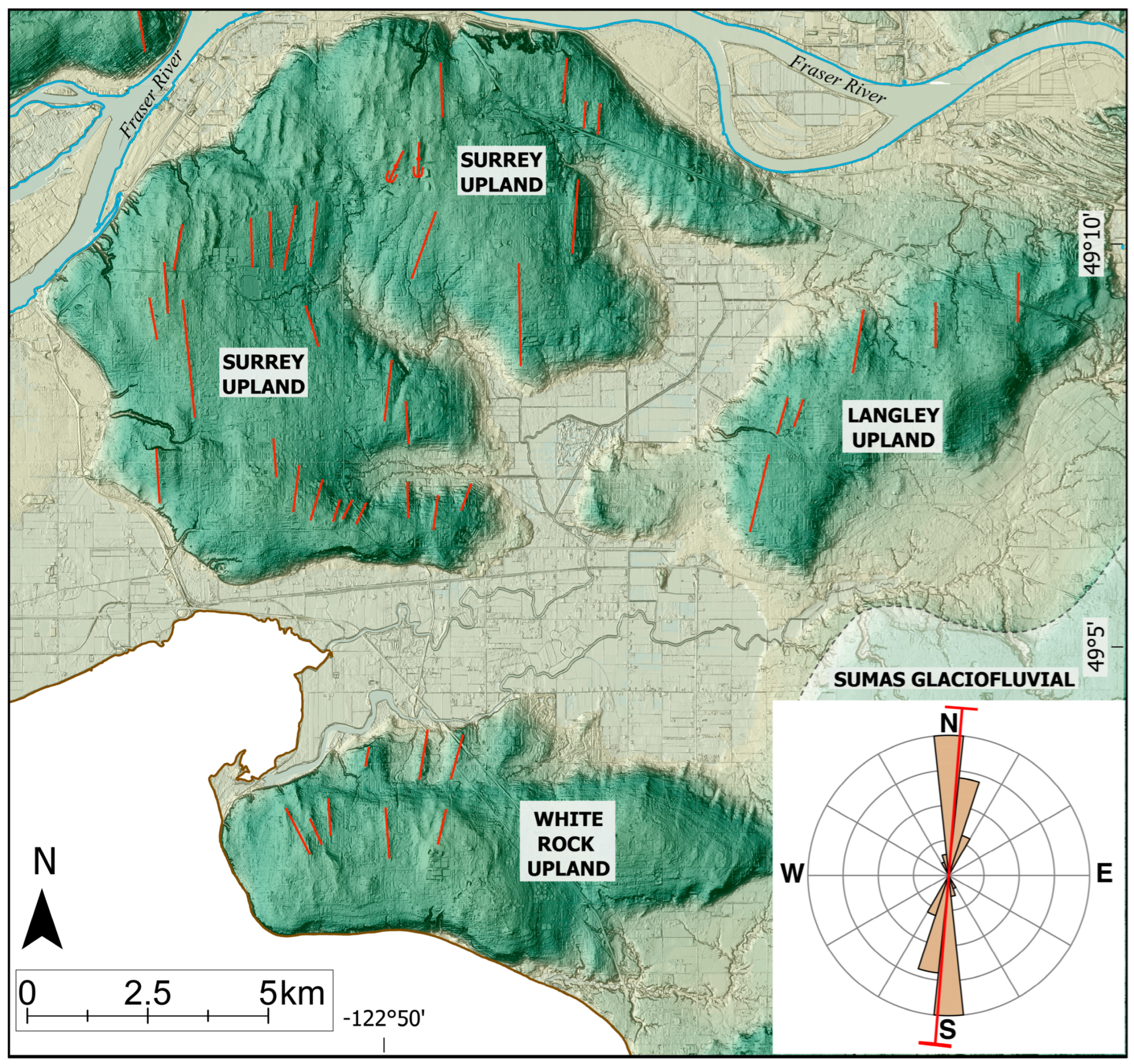
4.4. Radiocarbon Ages
5. Discussion
5.1. General Southward Flow and Deglaciation
5.2. Implications for the Coquitlam Stade
6. Conclusions
Supplementary Materials
Author Contributions
Funding
Institutional Review Board Statement
Informed Consent Statement
Data Availability Statement
Acknowledgments
Conflicts of Interest
References
- Johnson, M.D.; Fredin, O.; Ojala, A.E.K.; Peterson, G. Unraveling Scandinavian geomorphology: The LiDAR revolution. GFF 2015, 137, 245–251. [Google Scholar] [CrossRef]
- Smith, M.J.; Rose, J.; Booth, S. Geomorphological mapping of glacial landforms from remotely sensed data: An evaluation of the principal data sources and an assessment of their quality. Geomorphology 2006, 76, 148–165. [Google Scholar] [CrossRef]
- Putkinen, N.; Eyles, N.; Putkinen, S.; Ojala, A.E.K.; Palmu, J.-P.; Sarala, P.; Väänänen, T.; Räisänen, J.; Saarelainen, J.; Ahtonen, N.; et al. High-resolution LiDAR mapping of glacial landforms and ice stream lobes in Finland. Bull. Geol. Soc. Finl. 2017, 89, 64–81. [Google Scholar] [CrossRef]
- Clague, J.J.; Ward, B. Chapter 44—Pleistocene Glaciation of British Columbia. In Developments in Quaternary Sciences; Ehlers, J., Gibbard, P.L., Hughes, P.D., Eds.; Elsevier: Amsterdam, The Netherlands, 2011; Volume 15, pp. 563–573. [Google Scholar]
- Blaise, B.; Clague, J.J.; Mathewes, R.W. Time of maximum Late Wisconsin glaciation, West Coast of Canada. Quat. Res. 1990, 34, 282–295. [Google Scholar] [CrossRef]
- Clague, J.J.; James, T.S. History and isostatic effects of the last ice sheet in southern British Columbia. Quat. Sci. Rev. 2002, 21, 71–87. [Google Scholar] [CrossRef]
- Ryder, J.; Fulton, R.; Clague, J. The Cordilleran Ice Sheet and the glacial geomorphology of southern and central British Colombia. Géographie Phys. Quat. 1991, 45, 365–377. [Google Scholar] [CrossRef]
- Booth, D.B.; Troost, K.G.; Clague, J.J.; Waitt, R.B. The Cordilleran Ice Sheet. Dev. Quat. Sci. 2003, 1, 17–43. [Google Scholar] [CrossRef]
- Armstrong, J.E. Environmental and engineering applications of the surficial geology of the Fraser Lowland, British Columbia. Geol. Surv. Can. Pap. 1984, 83, 54. [Google Scholar] [CrossRef]
- Hicock, S.R.; Armstrong, J.E. Coquitlam Drift: A pre-Vashon Fraser glacial formation in the Fraser Lowland, British Columbia. Can. J. Earth Sci. 1981, 18, 1443–1451. [Google Scholar] [CrossRef]
- Hicock, S.R.; Hebda, R.J.; Armstrong, J.E. Lag of the Fraser glacial maximum in the Pacific Northwest: Pollen and macrofossil evidence from western Fraser Lowland, British Columbia. Can. J. Earth Sci. 1982, 19, 2288–2296. [Google Scholar] [CrossRef]
- Clague, J.J.; Froese, D.; Hutchinson, I.; James, T.S.; Simon, K.M. Early growth of the last Cordilleran ice sheet deduced from glacio-isostatic depression in southwest British Columbia, Canada. Quat. Res. 2005, 63, 53–59. [Google Scholar] [CrossRef]
- Hicock, S.R.; Lian, O.B. Cordilleran Ice Sheet lobal interactions and glaciotectonic superposition through stadial maxima along a mountain front in southwestern British Columbia, Canada. Boreas 1999, 28, 531–542. [Google Scholar] [CrossRef]
- Lian, O.B.; Hickin, E.J. Late Pleistocene stratigraphy and chronology of lower Seymour Valley, southwestern British Columbia. Can. J. Earth Sci. 1993, 30, 841–850. [Google Scholar] [CrossRef]
- Lian, O.B.; Hicock, S.R. Insight into the character of palaeo-ice-flow in upland regions of mountain valleys during the last major advance (Vashon Stade) of the Cordilleran Ice Sheet, southwest British Columbia, Canada. Boreas 2010, 39, 171–186. [Google Scholar] [CrossRef]
- Hicock, S.R.; Lian, O.B. The Sisters Creek Formation: Pleistocene sediments representing a nonglacial interval in southwestern British Columbia at about 18 ka. Can. J. Earth Sci. 1995, 32, 758–767. [Google Scholar] [CrossRef]
- Jackson, L.E.; Ward, B.C.; Hicock, S.R.; Gromig, R.; Clague, J.J.; Turner, D.G. New insights into the glacial and relative sea-level history of the western Fraser Lowland based on sediment cores from geotechnical drilling for the Evergreen Tunnel, British Columbia, Canada. Quat. Res. 2024, 122, 40–61. [Google Scholar] [CrossRef]
- Ward, B.C.; Thomson, B. Late Pleistocene stratigraphy and chronology of lower Chehalis River valley, southwestern British Columbia: Evidence for a restricted Coquitlam Stade. Can. J. Earth Sci. 2004, 41, 881–895. [Google Scholar] [CrossRef]
- Thorson, R.M. Ice-Sheet glaciation of the Puget Lowland, Washington, during the Vashon Stade (Late Pleistocene). Quat. Res. 1980, 13, 303–321. [Google Scholar] [CrossRef]
- Kovanen, D.; Slaymaker, O. The paraglacial geomorphology of the Fraser Lowland, southwest British Columbia and northwest Washington. Geomorphology 2015, 232, 78–93. [Google Scholar] [CrossRef]
- Porter, S.C.; Swanson, T.W. Radiocarbon Age Constraints on Rates of Advance and Retreat of the Puget Lobe of the Cordilleran Ice Sheet during the Last Glaciation. Quat. Res. 1998, 50, 205–213. [Google Scholar] [CrossRef]
- Hicock, S.R.; Armstrong, J.E. Vashon Drift: Definition of the formation in the Georgia Depression, southwest British Columbia. Can. J. Earth Sci. 1985, 22, 748–757. [Google Scholar] [CrossRef]
- McKenzie, M.A.; Miller, L.E.; Lepp, A.P.; DeWitt, R. Spatial variability of marine-terminating ice sheet retreat in the Puget Lowland. Clim. Past 2024, 20, 891–908. [Google Scholar] [CrossRef]
- Lian, O.B.; Mathewes, R.W.; Hicock, S.R. Palaeoenvironmental reconstruction of the Port Moody Interstade, a nonglacial interval in southwestern British Columbia at about 18 000 14C years BP. Can. J. Earth Sci. 2001, 38, 943–952. [Google Scholar] [CrossRef]
- Bustin, A.M.M.; Clowes, R.M.; Monger, J.W.H.; Journeay, J.M. The southern Coast Mountains, British Columbia: New interpretations from geological, seismic reflection, and gravity data. Can. J. Earth Sci. 2013, 50, 1033–1050. [Google Scholar] [CrossRef]
- Roddick, J.A.; Price, R.A.; Heywood, W. Vancouver North, Coquitlam, and Pitt Lake Map-areas, British Columbia: With Special Emphasis on the Evolution of the Plutonic Rocks. Geol. Surv. Can. Mem. 1965, 335, 276. [Google Scholar]
- Clague, J.J.; Luternauer, J.L.; Hebda, R.J. Sedimentary environments and postglacial history of the Fraser Delta and lower Fraser Valley, British Columbia. Can. J. Earth Sci. 1983, 20, 1314–1326. [Google Scholar] [CrossRef]
- McKenzie, M.A.; Simkins, L.M.; Principato, S.M.; Munevar Garcia, S. Streamlined subglacial bedform sensitivity to bed characteristics across the deglaciated Northern Hemisphere. Earth Surf. Process. Landf. 2022, 47, 2341–2356. [Google Scholar] [CrossRef]
- Schoof, C.G.; Clarke, G.K.C. A model for spiral flows in basal ice and the formation of subglacial flutes based on a Reiner-Rivlin rheology for glacial ice. J. Geophys. Res. Solid Earth 2008, 113, B05204. [Google Scholar] [CrossRef]
- Syverson, K.M. The ability of ice-flow indicators to record complex, historic deglaciation events, Burroughs Glacier, Alaska. Boreas 1995, 24, 232–244. [Google Scholar] [CrossRef]
- Benn, D.I.; Evans, D.J.A. Glaciers and Glaciation, 2nd ed.; Hodder Education: London, UK, 2010; p. 802. [Google Scholar]
- Clark, C.D.; Hughes, A.L.C.; Greenwood, S.L.; Spagnolo, M.; Ng, F.S.L. Size and shape characteristics of drumlins, derived from a large sample, and associated scaling laws. Quat. Sci. Rev. 2009, 28, 677–692. [Google Scholar] [CrossRef]
- Spagnolo, M.; Clark, C.D.; Hughes, A.L.C.; Dunlop, P.; Stokes, C.R. The planar shape of drumlins. Sediment. Geol. 2010, 232, 119–129. [Google Scholar] [CrossRef]
- Spagnolo, M.; Clark, C.D.; Hughes, A.L.C.; Dunlop, P. The topography of drumlins; assessing their long profile shape. Earth Surf. Process. Landf. 2011, 36, 790–804. [Google Scholar] [CrossRef]
- Gordon, J.E.; Brian Whalley, W.; Gellatly, A.F.; Vere, D.M. The formation of glacial flutes: Assessment of models with evidence from Lyngsdalen, North Norway. Quat. Sci. Rev. 1992, 11, 709–731. [Google Scholar] [CrossRef]
- Armstrong, J.E.; Hicock, S.R. Surficial geology, Vancouver, British Columbia. Geological Survey of Canada, Map 1486A, Scale 1:50,000; 1979. Available online: https://ostrnrcan-dostrncan.canada.ca/entities/publication/67e8a376-fce2-4c02-bb67-c30b2fdef80d (accessed on 3 July 2024).
- Armstrong, J.E.; Hicock, S.R. Surficial geology, New Westminster, west of sixth meridian, British Columbia. Geological Survey of Canada, “A” Series Map 1484A, Scale 1:50,000; 1980. Available online: https://ostrnrcan-dostrncan.canada.ca/handle/1845/112051 (accessed on 3 July 2024).
- Polach, H.A.; Stuiver, M. Discussion reporting of 14C data. Radiocarbon 1977, 19, 355–363. [Google Scholar] [CrossRef]
- Reimer, P.J.; Austin, W.E.N.; Bard, E.; Bayliss, A.; Blackwell, P.G.; Bronk Ramsey, C.; Butzin, M.; Cheng, H.; Edwards, R.L.; Friedrich, M.; et al. The IntCal20 Northern Hemisphere radiocarbon age calibration curve (0–55 cal kBP). Radiocarbon 2020, 62, 725–757. [Google Scholar] [CrossRef]
- Clark, C.D. Mega-scale glacial lineations and cross-cutting ice-flow landforms. Earth Surf. Process. Landf. 1993, 18, 1–29. [Google Scholar] [CrossRef]
- Haugerud, R.A. Deglaciation of the Puget Lowland, Washington. In Untangling the Quaternary Period—A Legacy of Stephen C. Porter; Waitt, R.B., Thackray, G.D., Gillespie, A.R., Eds.; Geological Society of America: Boulder, CO, USA, 2021; Volume 548, pp. 279–298. [Google Scholar]
- Stokes, C.R.; Clark, C.D.; Winsborrow, M.C.M. Subglacial bedform evidence for a major palaeo-ice stream and its retreat phases in Amundsen Gulf, Canadian Arctic Archipelago. J. Quat. Sci. 2006, 21, 399–412. [Google Scholar] [CrossRef]
- Evans, D.J.A.; Atkinson, N.; Phillips, E. Glacial geomorphology of the Neutral Hills Uplands, southeast Alberta, Canada: The process-form imprints of dynamic ice streams and surging ice lobes. Geomorphology 2020, 350, 106910. [Google Scholar] [CrossRef]
- Benediktsson, Í.Ö.; Aradóttir, N.; Ingólfsson, Ó.; Brynjólfsson, S. Cross-cutting palaeo-ice streams in NE-Iceland reveal shifting Iceland Ice Sheet dynamics. Geomorphology 2022, 396, 108009. [Google Scholar] [CrossRef]
- Riedel, J.L.; Clague, J.J.; Ward, B.C. Timing and extent of early marine oxygen isotope stage 2 alpine glaciation in Skagit Valley, Washington. Quat. Res. 2010, 73, 313–323. [Google Scholar] [CrossRef]
- Clark, P.U.; Dyke, A.S.; Shakun, J.D.; Carlson, A.E.; Clark, J.; Wohlfarth, B.; Mitrovica, J.X.; Hostetler, S.W.; McCabe, A.M. The Last Glacial Maximum. Science 2009, 325, 710–714. [Google Scholar] [CrossRef] [PubMed]
- Palacios, D.; Stokes, C.R.; Phillips, F.M.; Clague, J.J.; Alcalá-Reygosa, J.; Andrés, N.; Angel, I.; Blard, P.-H.; Briner, J.P.; Hall, B.L.; et al. The deglaciation of the Americas during the Last Glacial Termination. Earth-Sci. Rev. 2020, 203, 103113. [Google Scholar] [CrossRef]
- Gavin, D.G.; Brubaker, L.B. Postglacial Climate on the Olympic Peninsula. In Late Pleistocene and Holocene Environmental Change on the Olympic Peninsula, Washington; Gavin, D.G., Brubaker, L.B., Eds.; Springer International Publishing: Cham, Switzerland, 2015; pp. 51–60. [Google Scholar]
- Bartlein, P.J.; Anderson, K.H.; Anderson, P.M.; Edwards, M.E.; Mock, C.J.; Thompson, R.S.; Webb, R.S.; Webb Iii, T.; Whitlock, C. Paleoclimate simulations for North America over the past 21,000 years: Features of the simulated climate and comparisons with paleoenvironmental data. Quat. Sci. Rev. 1998, 17, 549–585. [Google Scholar] [CrossRef]
- Munroe, J.S.; Laabs, B.J.C. Temporal correspondence between pluvial lake highstands in the southwestern US and Heinrich Event 1. J. Quat. Sci. 2013, 28, 49–58. [Google Scholar] [CrossRef]
- Barrie, J.; Conway, K. A preliminary interpretation of surficial marine geology of central and northern Strait of Georgia, British Columbia. Geol. Surv. Can. Curr. Res. 2000, 2000-A21, 1–7. [Google Scholar]
- Luternauer, J.L.; Clague, J.J.; Feeney, T.D. A 367 m core from south western Fraser River delta, British Columbia. In Current Research, Part E, Geological Survey of Canada Paper 91; Geological Survey of Canada: Ottawa, ON, Canada, 1991; pp. 127–134. [Google Scholar]
- Clague, J.J.; Luternauer, J.L.; Monahan, P.A.; Edwardson, K.A.; Dallimore, S.R.; Hunter, J.A. Quaternary stratigraphy and evolution of the Fraser delta. Geol. Surv. Can. Bull. 1998, 525, 57–90. [Google Scholar]


| Sample no. | UCIAMS 1 no. | Dated Material | Sample Location | Fraction Modern | D1 4C ‰ | 14 C Age 2 | 1σ Error | Cal. Age Range (yr BP) 3 | |
|---|---|---|---|---|---|---|---|---|---|
| Lat. (W) | Long (W) | ||||||||
| CIA 2019-1 4 | 233906 | Wood | 49.29.2° | 123.43.9° | 0.0345 | −965.5 | 27,050 | 130 | 31,005–31,295 |
| CIA 2019-4 5 | 233907 | Cone | 49.29.2° | 123.43.9° | 0.0536 | −946.4 | 23,500 | 150 | 27,355–27,867 |
| CIA 2019-4 | 233908 | Cone | 49.29.2° | 123.43.9° | 0.0352 | −964.8 | 26,890 | 140 | 30,904–31,208 |
Disclaimer/Publisher’s Note: The statements, opinions and data contained in all publications are solely those of the individual author(s) and contributor(s) and not of MDPI and/or the editor(s). MDPI and/or the editor(s) disclaim responsibility for any injury to people or property resulting from any ideas, methods, instructions or products referred to in the content. |
© 2025 by the authors. Licensee MDPI, Basel, Switzerland. This article is an open access article distributed under the terms and conditions of the Creative Commons Attribution (CC BY) license (https://creativecommons.org/licenses/by/4.0/).
Share and Cite
Gromig, R.; Franz, K.; Ward, B.; Clague, J.J. Ice-Flow Dynamics During the Final Stage of the Fraser Glaciation (MIS2) in the Fraser Lowland, BC, Canada. Quaternary 2025, 8, 13. https://doi.org/10.3390/quat8010013
Gromig R, Franz K, Ward B, Clague JJ. Ice-Flow Dynamics During the Final Stage of the Fraser Glaciation (MIS2) in the Fraser Lowland, BC, Canada. Quaternary. 2025; 8(1):13. https://doi.org/10.3390/quat8010013
Chicago/Turabian StyleGromig, Raphael, Kenya Franz, Brent Ward, and John J. Clague. 2025. "Ice-Flow Dynamics During the Final Stage of the Fraser Glaciation (MIS2) in the Fraser Lowland, BC, Canada" Quaternary 8, no. 1: 13. https://doi.org/10.3390/quat8010013
APA StyleGromig, R., Franz, K., Ward, B., & Clague, J. J. (2025). Ice-Flow Dynamics During the Final Stage of the Fraser Glaciation (MIS2) in the Fraser Lowland, BC, Canada. Quaternary, 8(1), 13. https://doi.org/10.3390/quat8010013







